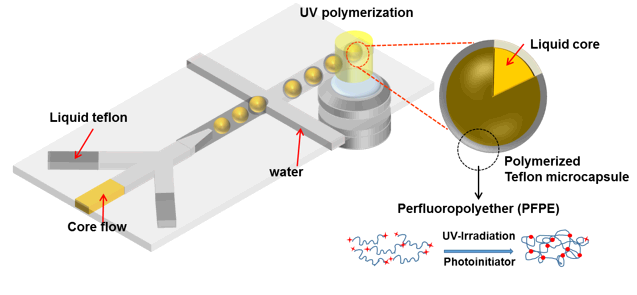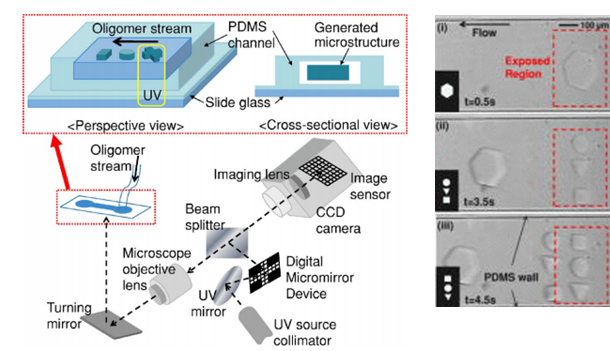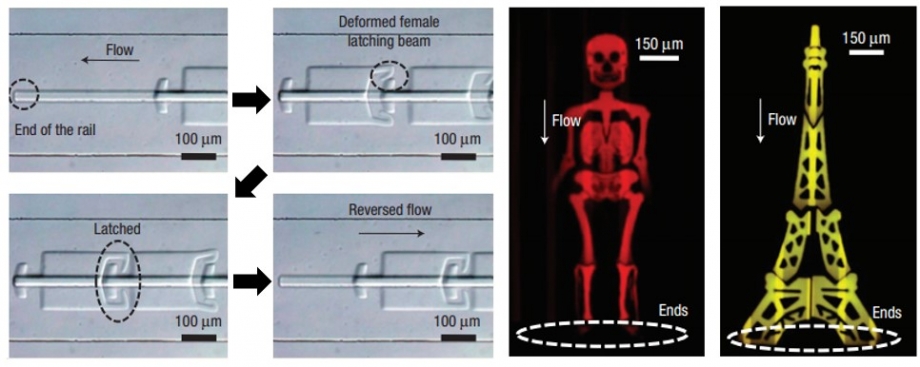Partipetting
We programmably assemble functional microparticles into complex systems. These systems can be utilized for various high-throughput bioassays and drug-screening.
Partipetting
We propose a novel handling technique of chemical substances termed ‘partipetting’, which allows the one-step pipetting of various chemical-laden hydrogels. We pipette and assemble various types of encoded chemical-laden microparticles in microwell arrays in parallel. The combination of this heterogeneous particle chip and a cell chip induces the release of the chemicals from the hydrogels and, eventually, the chemicals treat the targets.
Su Eun Chung, Jiyun Kim, Dong Yoon Oh, Younghoon Song, Sung Hoon Lee, Seungki Min & Sunghoon Kwon, "One-step pipetting and assembly of encoded chemical-laden microparticles for high-throughput multiplexed bioassays",Nature Communications, volume 5, 2014. [PDF]
"Advances in the production and handling of encoded microparticles", Research Highlight, Lab on a Chip, 2014, Advance Article.
Liquid-capped Particle
We propose a novel drug screening platform based on a our new concept of liquid handling method called ‘partipetting’, which enable whole drug screening with a single pipetting process. To demonstrate our concept of liquid handling, we present a generation of liquid capped microsphere particles, heterogeneous assembly of different liquid capped particles, breaking and releasing of these liquid capped microshell particles.

Optofluidic Maskless Lithography(OFML)
Optofluidic maskless lithography is a technique that can synthesize free-floating microstructures in microfluidic channels at the desired time and location within the field of view of the lithography system. By uniquely combining the concept of maskless and continuous-flow lithography techniques in the microfluidic channels, we experimentally demonstrate real-time control of the in-situ polymerization process to dynamically synthesize extruded polymeric microstructures with various two-dimensional shapes.
Su Eun Chung, Wook Park, Hyungsung Park, Kyoungsik Yu, Namkyoo Park, Sunghoon Kwon, "Optofluidic maskless lithography system for real-time synthesis of photopolymerized microstructures in microfluidic channels", Applied Physics Letters, Vol. 91, No. 4, p. 041106, 2007. [PDF]
Color-barcoded Microparticle
We propose vivid, free-floating structural coloured particles with multi-axis rotational control using a colour-tunable magnetic material and a new printing method. Our colour-barcoded magnetic microparticles offer a coding capacity easily into the billions with distinct magnetic handling capabilities including active positioning for code readouts and active stirring for improved reaction kinetics in microscale environments. A DNA hybridization assay is done using the colour-barcoded magnetic microparticles to demonstrate multiplexing capabilities.

Howon Lee, Junhoi Kim, Hyoki Kim, Jiyun Kim, Sunghoon Kwon, "Colour-barcoded magnetic microparticles for multiplexed bioassays", Nature Materials, 9, 745-749, 2010 [Cover article September 2010] [PDF]
"Colour-coded microcarriers: Made to move",
News & Views, Nature Material,
Vol. 9, p.697-698, 2010"Biomagnetic materials: rainbow diagnostics",
Latest News articles, IOP Asia-Pacific,
sep 30, 2010 [PDF]
Railed Microfluidics
“Railed microfluidics,” is a fully deterministic way of guiding microstructures inside a fluidic channel. Using railed microfluidics, we achieved fluidic self assembly of various complex heterogeneous microstructures. By transporting many different microstructures to exact assembly sites, complex 1D and 2D systems are assembled without wasting a single microstructure.
Su Eun Chung, Wook Park, Sunghwan Shin, Seung Ah Lee, and Sunghoon Kwon, "Guided and fluidic self-assembly of microstructures using railed microfluidic channels", Nature Materials, Vol. 5, p.581-587, 2008. [Cover article July 2008] [PDF]
"Groove train", Research Highlights, Nature, Vol. 453, p.1147, 26 June 2008




